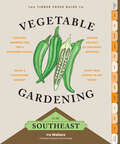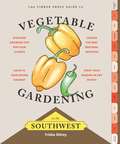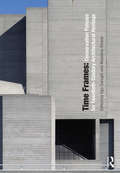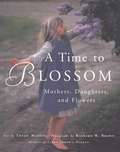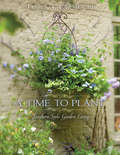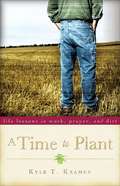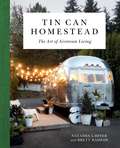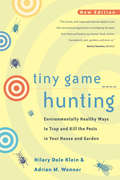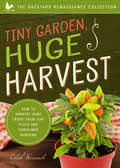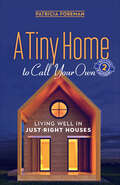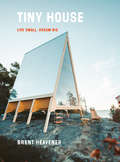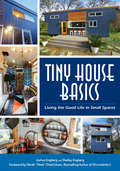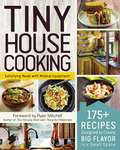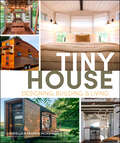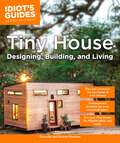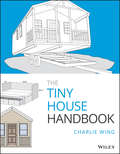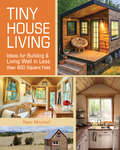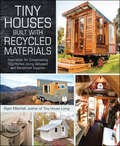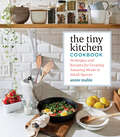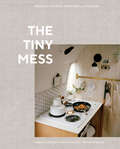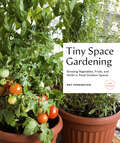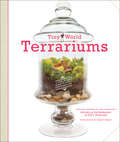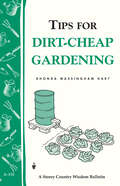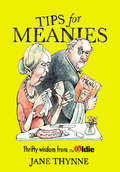- Table View
- List View
The Timber Press Guide to Vegetable Gardening in the Southeast (Regional Vegetable Gardening Series)
by Ira WallaceGrowing vegetables requires regionally specific information—what to plant, when to plant it, and when to harvest are based on climate, weather, and first frost. The Timber Press Guide to Vegetable Gardening in the Southeast tackles this need head on, with regionally specific growing information written by local gardening expert, Ira Wallace. This region includes Alabama, Arkansas, Florida, Georgia, Kentucky, Louisiana, Maryland, Mississippi, North Carolina, South Carolina, Tennessee, Virginia, and West Virginia. Monthly planting guides show exactly what you can do in the garden from January through December. The skill sets go beyond the basics with tutorials on seed saving, worm bins, and more.
Timber Press Guide to Vegetable Gardening in the Southwest (Regional Vegetable Gardening Series)
by Trisha ShireyThere is nothing more regionally specific than vegetable gardening—what to plant, when to plant it, and when to harvest are decisions based on climate, weather, and first frost. The Timber Press Guide to Vegetable Gardening in the Southwest, by regional expert Trisha Shirey, focuses on the unique eccentricities of the Southwest gardening calendar, which include extreme temperatures and low rainfall. The month-by-month format makes it perfect for beginners and accessible to everyone— gardeners can start gardening the month they pick it up. Perfect for home gardeners in Arizona, Nevada, New Mexico, Oklahoma, Texas, Utah, eastern California, and southern Colorado.
Time Frames: Conservation Policies for Twentieth-Century Architectural Heritage
by Ugo Carughi Massimo VisoneTime Frames provides a reconnaissance on the conservation rules and current protection policies of more than 100 countries, with particular attention to the emerging nations and twentieth-century architecture. The contributions illustrate the critical issues related to architectural listings, with a brief history of national approaches, a linkography and a short bibliography. The book also provides a short critical lexicography, with 12 papers written by scholars and experts including topics on identities, heritages, conservation, memories and the economy. By examining the methods used to designate building as heritage sites across the continents, this book provides a comprehensive overview of current protection policies of twentieth-century architecture as well as the role of architectural history.
A Time to Blossom
by Tovah MartinFor generations, a love of flowers, an understanding of nature, and a knowledge of the secrets of plants has passed seamlessly from mother to daughter to granddaughter. In its deliciously entertaining text and through its beautiful photographs, A TIME TO BLOSSOM captures the essence of childhood. Whether she is climbing an apple tree, squirming through a proper tea-party visit with an elderly neighbor, dashing to hang a May basket on a friend's door, or sitting crowded and cranky on a Sunday ride with the family, Tovah Martin's childhood memories will captivate the reader. With Richard Brown's glorious photography, A TIME TO BLOSSOM reminds us of the authors' earlier book, TASHA TUDOR'S GARDEN. The text is frank, impish, nostalgic, but never cloying or sentimental. It is a recollection of childhood with all the mischief, the mystery, and the innocence intact. And for readers who want to enjoy their own mother and daughter flower projects, A TIME TO BLOSSOM is filled with practical instructions: How to make a hollyhock doll; weave a garland; press pansies, bake a scented geranium cake, force bulbs, dry flowers, make rose potpourri, grow a giant amaryllis, and much much more.
A Time to Plant
by James T. Farmer IIIFrom the author who&’s &“one part Wendell Barry, one part Martha Stewart . . . one of the most refreshing takes on &‘locavore&’ you&’ll see this year&” (St. Louis Magazine). A vital young voice in the gardening scene teaches a new generation of Southerners to love gardening and to make it a focal point of their lifestyle. James Farmer III teaches respect for the age-old rules of flower and vegetable gardening in the Deep South (e.g., May is the time for pruning), in a fresh voice that resonates love of life and entertaining at home. Also included are delicious recipes for seasonal meals, as well as suggestions for floral arrangements and centerpieces from the garden. Praise for James T. Farmer and his books &“A Southern gentleman who&’s just as charming in the garden as he is in the kitchen. He&’s compiled all his botanical experiences into A Time to Plant.&”—Harper&’s Bazaar &“A Time to Cook, A Time to Plant and A Time to Celebrate are titles of three of his books that inspire readers to cultivate, decorate and salivate over their own efforts in the kitchen. His books contain descriptive text combined with colorful photographs and garden-to-table recipes.&”—The Virginian-Pilot
A Time to Plant: Life Lessons in Work, Prayer, and Dirt
by Kyle T. KramerIn this book, Kyle Kramer recounts the gritty story of how he came to experience the joys of real community through a journey of honest reckoning with his own ambitions. "A Time to Plant" is a deeply human story of one man's attempt to make simple living a reality as a spiritual discipline for himself, as a model for his children, and for the good of creation.
Tin Can Homestead: The Art of Airstream Living
by Natasha LawyerDIY enthusiasts, tiny house-lovers, and van-lifers will find inspiration and step-by-step instructions in Tin Can Homestead, the ultimate resource for living small in your own Airstream paradise.The Airstream trailer is the ultimate symbol of vintage wanderlust-and the classic touring vehicle's resurgent popularity has dovetailed with the tiny house movement, resonating with design-minded individuals looking to live small. Tin Can Homestead, based on the popular Instagram of the same name, is the ultimate resource for these would-be DIY-ers, and the perfect coffee-table addition for anyone looking for streamlined, modern lifestyle inspiration.Part practical how-to, part lushly illustrated design inspiration, Tin Can Homestead follows the story of one couple as they build themselves a new life in an old Airstream. Through personal stories and down-and-dirty checklists, this book guides readers through all stages of creating their own Airstream homes-from buying a trailer to plumbing and electrical work. With a hip, bohemian aesthetic and a fresh authorial voice, the authors pair their DIY knowledge with lifestyle advice-including décor, design, and entertaining-and abundant illustrations, from in-process photographs to hand-drawn illustrations.
Tiny Game Hunting: Environmentally Healthy Ways to Trap and Kill the Pests in Your House and Garden
by Courtlandt Johnson Hilary Dole Klein Adrian M. WennerEvery year Americans use a staggering five hundred million pounds of toxic pesticides in and around their homes, schools, parks, and roads--a growing health risk for people and the environment. But are these poisons really necessary? This book, appealing to the hunter in us all, shows how to triumph in combat with pests without losing the war to toxic chemicals. Tiny Game Hunting, written in a lively and entertaining style and illustrated with detailed drawings, gives more than two hundred tried-and-true ways to control or kill common household and garden pests without using toxic pesticides.
Tiny Garden, Huge Harvest: How to Harvest Huge Crops From Tiny Plots and Container Gardens (The Backyard Renaissance Collection)
by Caleb WarnockThe self-sufficiency expert and backyard gardening author presents a comprehensive guide to growing bountiful harvests without bountiful land.With his Backyard Renaissance Collection of how-to guides, Caleb Warnock has been helping people rediscover the simple pleasures of self-reliance. In Tiny Garden, Huge Harvest, Warnock demonstrates how a small garden plot or container garden can produce huge volumes of fresh food.The secret to a productive garden is using the right varieties of heirloom vegetables. From choosing the right seeds to maximizing your crops, Warnock provides step-by-step directions for designing, planting, and harvesting a tiny garden for big harvests that can really feed your family.
A Tiny Home to Call Your Own: Living Well in Just-Right Houses
by Patricia ForemanUnfetter and unclutter your life by learning how and why to transition to a tiny homeDo you feel as though you're living in an expensive and ill-fitting home filled with too much stuff? Do you have too much space filled with too many things, constantly dealing with house maintenance and financial upkeep? Living in a tiny home could be the solution. But how do you know?Tiny house guru Pat Foreman examines the hows and whys of tiny-home living, to help you assess whether it's the right solution for you. A Tiny Home to Call Your Own examines:The many uses of tiny homes for all age groups and different socio-economic levelsHow smaller homes can buy you time, financial freedom, and an unfettered lifestyleStuff-ology: understanding what things do and do not serve youEcology and the Tiny House movementPre-existing tiny house communities.From newlyweds to empty-nesters, downsizers to retirees, and everyone in between, A Tiny Home to Call Your Own will help you to find and create the living space and housing you love and that will serve you and your future.
Tiny House: Live Small, Dream Big
by Brent HeavenerFrom the founder of the Instagram feed @TinyHouse, comes a small, chunky inspiration book filled with photographs of the smallest abodes—from vans and boats to tree houses and cabins. A die-cut cover acts as a window onto a simpler world of lighter living and sustainability that never sacrifices function or design.Imagine living debt-free in an environmentally-friendly home. No mortgage, no clutter, and boundless freedom. This is the reality and dream of people all over the world thanks to the widespread momentum of the tiny house movement in recent years. Designed to fit on the tiniest of coffee tables, this book features 250 full-color photographs of the smallest, most efficient homes around the world, with interviews, features, and smart tips straight from the homeowners. From tiny mobile homes in California, Nashville, and Minnesota to a surfer-built tree house in Washington to a school bus that has been converted to a camper in Oregon, this lookbook is packed with big inspiration.
Tiny House Basics: Living the Good Life in Small Spaces
by Joshua Engberg Shelley EngbergSmall, simple, sustainable: Tips and tricks for living the tiny house lifestyle! Tiny houses are skyrocketing in popularity, and in this book campers, off roaders, and tiny house living experts Shelley and Joshua Engberg show how you can join the revolution. Learn to downsize without giving up everything you hold dear—with tips on how your life can still be comfortable and entertaining in a tiny house living environment. You’ll learn about: How to maintain a good relationship in a small spacePractical downsizing for everyoneSmall space living with petsThe pros and cons of off grid living and on grid livingHow to make your small space feel bigKeeping your small space feeling fresh with practical storage solutions and design tipsEquipping your space for entertainingAccordion/bi-fold style windowsHow downsizing and simplifying your life will allow you more freedom and time
Tiny House Cooking: 175+ Recipes Designed to Create Big Flavor in a Small Space (Tiny House Living Series)
by Adams MediaNo need to curb your big appetite in a tiny home—here are 175 recipes uniquely designed to be made in the micro-kitchens of tiny homes and apartments.Tiny homes are the next big thing—frequently featured in HGTV shows such as Tiny House, Big Living and in popular lifestyle publications such as Good Housekeeping, tiny homes are gaining popularity for their economic and ecological sensibility. But with tiny homes come tiny kitchens—according to the Tiny House Blog, many tiny homes have only two burner stove tops, a mini-fridge, and no microwave or oven. At first glance, this may seem like a challenge, but Tiny House Cooking proves how easy cooking in a tight space can be! Featuring 50 beautiful full-color photos of tantalizing finished recipes and a foreword by tiny house living expert Ryan Mitchell, Tiny House Cooking includes 175 recipes especially designed for the pocket-sized abode—none of the recipes require an oven, microwave, toaster oven, freezer, full-sized refrigerator, or any other extraneous device—as well as information on essential equipment, space-saving ideas, and innovative ways to reduce and recycle creative waste. Find delicious new ideas for breakfast, sandwiches, appetizers, snacks, main dishes, desserts—and more!—all only using two pots at most.
Tiny House Designing, Building & Living
by Andrew Morrison Gabriella MorrisonDo you have what it takes to live tiny?Do you dream of simplifying your life, freeing up your financial resources and ditching all of the clutter in your life? Learn the ins and outs of what it really takes to achieve the dream of designing, building and living in a tiny house of 400 square feet or less!Tiny house professionals, Gabriella and Andrew Morrison, have been involved in the trade for over 20 years, helping others to construct their own tiny homes. They have instilled all of their expertise and firsthand experience into this newly updated guide.Tiny House Designing, Building & Living is the one-stop manual into the innovative concept of minimalist living. There are dozens of helpful images and a full-color insert displaying different varieties of tiny houses to help you conceptualize your dream.In this newly updated guide you'll discover: • Advice on how to embrace the tiny house lifestyle!• How to design and build a house that's an ideal fit for your needs.• The variations of foundation types, financing, insurance and legal standards.• Building techniques, must-have utilities, off-the-grid living and home placement.• Inspiration for functional décor and storage.• Three tiny house floor plans with detailed illustrations!
Tiny House Designing, Building, & Living (Idiot's Guides)
by Andrew Morrison Gabriella MorrisonDo you have what it takes to live tiny?Do you dream of simplifying your life, freeing up your financial resources, and ditching all of the clutter that's weighing you down? Learn the nuts and bolts of what it really takes to achieve this dream of designing, building, and living in a tiny house of 400 square feet or less!Tiny house professionals Gabriella and Andrew Morrison have been involved in the trade for over 20 years, helping others to construct their own tiny homes, and they have poured all of their expertise and firsthand experience into this guide.Tiny House Designing, Building, and Living is the one-stop manual into this innovative concept of minimalist living. Dozens of helpful images and a full-color insert displaying different types of tiny houses help you visualize your dream. • Advice on how to embrace the tiny house lifestyle! • How to design and build a house that's an ideal fit for your needs. • The nuances of foundation types, financing and insurance, and legal standards • Building techniques, must-have utilities, off-the-grid living, and home placement. • Inspiration for functional décor and storage. • Three tiny house floor plans, with detailed illustrations!
The Tiny House Handbook
by Charlie Wing“This thought provoking book is a great resource for anyone considering joining the tiny house movement. It’s all the information you need in one book! The author has done a phenomenal job blending real world experience, data and practical knowledge on all types of tiny homes.”-Corinne Watson, Principle and Co-Founder, Tiny Homes of Maine“Charlie Wing’s very readable Tiny House Handbook leads you through the processes of designing and building a tiny home, with careful attention to all the details, including legal issues, cost estimates, material utilization and foundation options. Charlie is a master at demystifying the seemingly complex process of homebuilding. This book will help you live both comfortably and lighter on the land.“-John S. Crowley, CEO of FACET and Board member, Build It GreenPlan, design, and build a tiny house from scratch The Tiny House Handbook is a comprehensive guide to everything you need to know to construct your very own tiny house. Produced in Charlie Wing’s signature “visual handbook” style and jam-packed with full-color illustrations and diagrams, this book includes step-by-step instructions for building a tiny house as well as information on cost estimating and design requirements. Based on 2018 International Residential Code (IRC) Appendix Q, this book includes sample construction drawings and floor plans for a variety of tiny home styles, including: · Mobile (8'6”-wide trailers and RVs) · Movable (12'-wide, routine transport permit) · Site-built (up to 20’ wide) Rather than being just another inspirational collection of tiny home photographs, The Tiny House Handbook constitutes a complete and fulsome reference for anyone seeking to build their own tiny home. From seasoned construction vets to total novices, this book will walk you through the process of designing and building a tiny house from start to finish.
Tiny House Living: Ideas For Building & Living Well in Less than 400 Square Feet
by Ryan MitchellTiny House, Large Lifestyle!Tiny homes are popping up across America, captivating people with their novel approach not only to housing, but to life. Once considered little more than a charming oddity, the tiny house movement continues to gain momentum among those who thirst for a simpler, "greener," more meaningful life in the face of society's "more is better" mindset.This book explores the philosophies behind the tiny house lifestyle, helps you determine whether it's a good fit for you, and guides you through the transition to a smaller space. For inspiration, you'll meet tiny house pioneers and hear how they built their dwellings (and their lives) in unconventional, creative and purposeful ways. They'll invite you in, show you around their cozy abodes, and share lessons they learned along the way.Inside you'll find everything you need to design a tiny home of your own:Worksheets and exercises to help you home in on your true needs, define personal goals, and develop a tiny house layout that's just right for you.Practical strategies for cutting through clutter and paring down your possessions.Guidance through the world of building codes and zoning laws.Design tricks for making the most of every square foot, including multi-function features and ways to maximize vertical space.Tours of 11 tiny houses and the unique story behind each.Tiny House Living is about distilling life down to that which you value most...freeing yourself from clutter, mortgages and home maintenance...and, in doing so, making more room in everyday life for the really important things, like relationships, passions and community. Whether you downsize to a 400-square-foot home or simply scale back the amount of stuff you have in your current home, this book shows you how to live well with less.
Tiny Houses Built with Recycled Materials: Inspiration for Constructing Tiny Homes Using Salvaged and Reclaimed Supplies
by Ryan MitchellJoin the tiny house trend! The tiny house movement is a big trend with a very small footprint. Extremely small house, with less than 1,000 square feet of space, are environmentally friendly, less expensive than typical homes, and often movable. Tiny Houses Built with Recycled Materials is full of ideas for using reclaimed materials and upcycled goods to construct a tiny house that is good for the earth and truly unique. Ryan Mitchell, author of The Tiny Life blog, shows you how to repurpose everyday items to create your new home, including shipping containers, salvaged barn wood, and reclaimed shingles. Featuring profiles on tiny house owners with photographs and floor plans of the homes, ideas on where to find materials, and what to look for and avoid when selecting reclaimed materials, Tiny Houses Built with Recycled Materials is a unique book perfect for your biggest DIY project yet!
Tiny Houses Built with Recycled Materials: Inspiration for Constructing Tiny Homes Using Salvaged and Reclaimed Supplies
by Ryan MitchellJoin the tiny house trend! The tiny house movement is a big trend with a very small footprint. Extremely small house, with less than 1,000 square feet of space, are environmentally friendly, less expensive than typical homes, and often movable. Tiny Houses Built with Recycled Materials is full of ideas for using reclaimed materials and upcycled goods to construct a tiny house that is good for the earth and truly unique. Ryan Mitchell, author of The Tiny Life blog, shows you how to repurpose everyday items to create your new home, including shipping containers, salvaged barn wood, and reclaimed shingles. Featuring profiles on tiny house owners with photographs and floor plans of the homes, ideas on where to find materials, and what to look for and avoid when selecting reclaimed materials, Tiny Houses Built with Recycled Materials is a unique book perfect for your biggest DIY project yet!
The Tiny Kitchen Cookbook: Strategies and Recipes for Creating Amazing Meals in Small Spaces
by Annie MahleWhether home is a small apartment, a tiny house or RV, a boat, or a college dorm room, space in the kitchen is nearly always at a premium. But cooking in a small kitchen, with minimal equipment, doesn't have to be limiting; it can actually be is a great opportunity to hone food-prep skills and become a more efficient, versatile home chef. And the smarter the workspace, the easier it is to cook. In The Tiny Kitchen Cookbook, chef Annie Mahle shares her small-space cooking strategies and 50 of her favorite recipes she developed as the galley chef aboard the J&E Riggin, a windjammer she operated with her husband off the coast of Maine for many summers. From her 6-by-8-foot kitchen, she prepared three beautiful, flavorful meals from scratch every day, for up to 30 people. From versatile breakfast options, such as Sweet Corn and Jalapeno Pancakes or Pan Roasted Honey Pears with Oatmeal, to one-bowl salads and mains, stovetop meals such as Pan-Fried Red Snapper with Fresh Peas, Shiitakes, and Asparagus with Dill, dishes that can be prepared in the toaster oven (for cooks without a full oven) such as Cheese-Stuffed Meatballs with Fresh Tomato Sauce and Fettuccini, and even make-ahead desserts in a mug, every recipe is delicious and utterly attainable in a kitchen with as little as six square feet of counter space. Along with gorgeous recipes, Mahle delivers tips and techniques for making the most of a small kitchen. Strategies such as &“shopping&” the pantry before going to the store, transforming leftovers into new meals, create vertical storage options, and buy utensils that nest all help create meals with maximum flavor in minimal space. This publication conforms to the EPUB Accessibility specification at WCAG 2.0 Level AA.
The Tiny Mess: Recipes and Stories from Small Kitchens
by Maddie Gordon Mary Gonzalez Trevor GordonA lushly photographed cookbook featuring more than 40 recipes from tiny kitchens, The Tiny Mess is a whimsical combination of stories, recipes, culinary adventure, and of course, petite and inspiring cooking spaces that prove constraints are nothing but an invitation for creativity.From sailboats and trailers, to treehouses, cottages, and converted railcars, The Tiny Mess is alive with stories of tiny houses, the people who live in them, and the meals they love the most. The book offers full-flavored recipes for kitchens of any size, featuring gorgeous photographs of intimate kitchens; the fresh, colorful food they produce; and the artisans, cooks, anglers, and farmers who own and work in them. A range of inventive dishes includes options for breakfast, lunch, dinner, and even cocktail hour, such as Sourdough Pancakes, Kitchen Sink Quiche, Nopal Cactus Salad, Slow-Stewed Rabbit Tacos, Blueberry and Lime Pie, and Rosemary-Honey Gin and Tonic. In addition to the recipes, the book includes narratives about the contributors, including their tips and tricks for essential equipment, pantry items, and small kitchen hacks.
Tiny Space Gardening: Growing Vegetables, Fruits, and Herbs in Small Outdoor Spaces (with Recipes)
by Amy PenningtonForget the 100-mile eat-local diet; try the 300-square-foot-diet — grow squash on the windowsill, flowers in the planter box, or corn in a parking strip. Apartment Gardening details how to start a garden in the heart of the city. From building a window box to planting seeds in jars on the counter, every space is plantable, and this book reveals that the DIY future is now by providing hands-on, accessible advice. Amy Pennington's friendly voice paired with Kate Bingham-Burt's crafty illustrations make greener living an accessible reality, even if readers have only a few hundred square feet and two windowsills. Save money by planting the same things available at the grocery store, and create an eccentric garden right in the heart of any living space.
Tiny World Terrariums: A Step-by-Step Guide to Easily Contained Life
by Michelle Inciarrano Katy MaslowCreate your own tiny, living world with this beautifully illustrated, easy-to-follow guide to terrariums using soil, plants, miniature figurines, and more! Terrariums are a vibrant, unique way to inject a little greenery into any home. In Tiny World Terrariums, authors Katy and Michelle of Brooklyn&’s celebrated Twig Terrariums offer step-by-step instructions for building your own, from selecting glass containers to layering soil and filtration to adding moss, succulents, and other plants. To give each terrarium a whimsical, personal touch, Katy and Michelle demonstrate how to use tiny figurines and toys to create to-scale scenes, such as a couple at their wedding, a CSI crime scene, and Central Park in springtime. Photos of gorgeously finished terrariums and detailed instructions will empower anyone―whether green-thumbed or not―to create their own Lilliputian worlds.&“The book provides all the necessary instructions to create successfully healthy terrariums . . . But illustrations are the real delight. They show all sorts of tiny world photos labeled with container types, plant names, and more so you can more easily create contained life exactly as you envision it.&” —Wired.com
Tips for Dirt-Cheap Gardening: Storey Country Wisdom Bulletin A-158 (Storey Country Wisdom Bulletin Ser.)
by Rhonda Massingham HartSince 1973, Storey's Country Wisdom Bulletins have offered practical, hands-on instructions designed to help readers master dozens of country living skills quickly and easily. There are now more than 170 titles in this series, and their remarkable popularity reflects the common desire of country and city dwellers alike to cultivate personal independence in everyday life.
Tips for Meanies: Thrifty Wisdom from The Oldie
by Jane ThynneTips for Meanies is an irreverent guide to thrift, the perfect present for the Meanies in your life that will equip them with new, versatile weapons for their armoury:- Discover the penny-pinching potential of everyday miracle products, from toothpaste and vinegar to barbecue briquettes- Find cunning ways to curb household shopping and energy bills- Avoid pricey trips to the chemist by channelling the healing powers of cheap and easy home remedies… everything Meanies need to keep their household clean, green – and very mean.
